📝 Thanks for reading Fran Magazine, a biweekly blog by Fran Hoepfner (me). The way this works is that Wednesday (regular) issues are free for all and Sunday (dispatch) and reread diary issues are for paid subscribers only. Consider subscribing or upgrading your subscription for access to more Fran Magazine, and feel free to follow me on Instagram or Letterboxd. 📝
Fran Magazine x Bugstack crossover event
For as long as Emma Stefansky and I have been friends, I’ve been sending her pictures of bugs with accompanying text that ranges from “help” to “what the hell” to “who is she?” Emma loves bugs and she knows bugs, and she’s especially great at telling me when not to be afraid of a certain bug, which is most of the time. While I was up in the Adirondacks, I saw more bugs that I’ve seen in a long, long time that aren’t the New York City varieties, e.g. ants, house centipedes, cockroaches (big and small), and lanternflies. This Fran Magazine x
crossover issue will showcase some of the best, weirdest, and freakiest bugs I saw up in the mountains.Hi Emma.
HI FRAN hold on im in a zoom
That’s okay. Now I have a migraine.
[three days pass]
Okay hi.
Hi Fran, and let me just say how overjoyed I was when you suggested this collab, which some may call the most ambitious crossover event in history. The only thing I enjoy more than seeing a bug in person is receiving pictures of bugs sent by beloved friends, and getting to show off by identifying them. While you were out in the wilderness, you were exposed to an enviable array of bugs, and I looked forward to living vicariously through your weekly dispatches. Before we get to the good stuff, I did want to ask: How did you feel about the bugs going into this experience? Were you excited about going to a location with a higher concentration of insect life?
I have a complicated relationship with bugs. My baseline reaction to most bugs is fear, but with some degree of distance — a glass enclosure, say, at a museum — I am completely enrapt by them. I love reading about bugs and looking at pictures of them, but when a bug is in my house, I go nuts. I hadn’t really considered the bugs I would encounter in the Adirondacks too strongly. When I camped a little north of there in Canada several years ago, I mostly remember mosquitos, big ants, and daddy longlegs (LONGLEGS NOW IN THEATERS). I didn’t anticipate the vast degree of bug diversity that I encountered once I was out in the mountains. I saw so many bugs, but I think the greatest variety of one type of bug that I saw were moths! Big moths! Colorful moths! I think moths get a bad rap because they aren’t butterflies. Tell me a little bit about big moths.
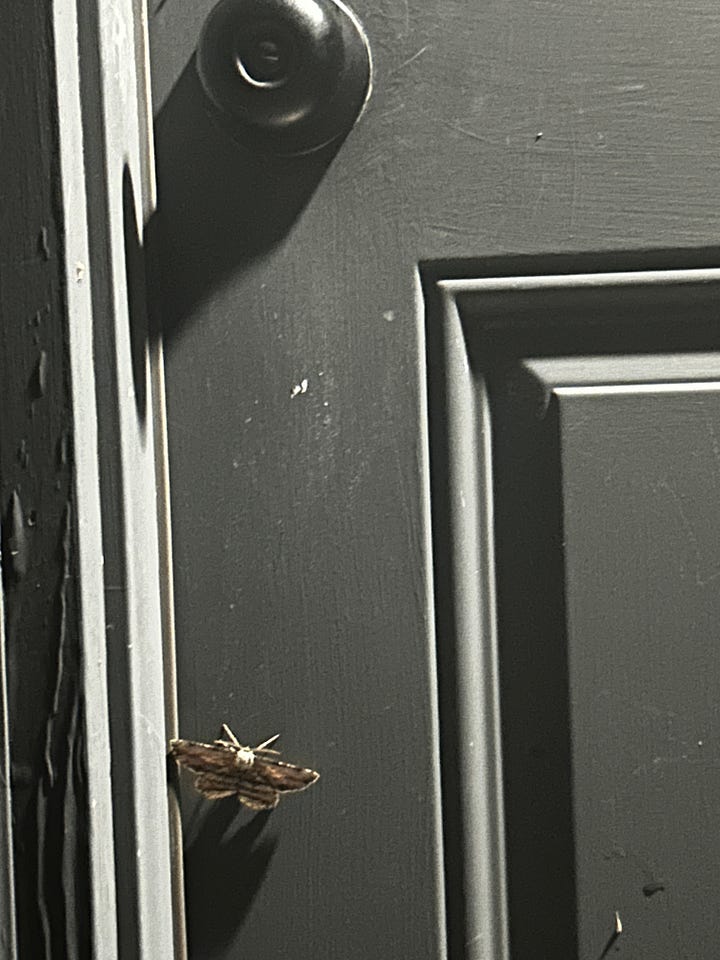
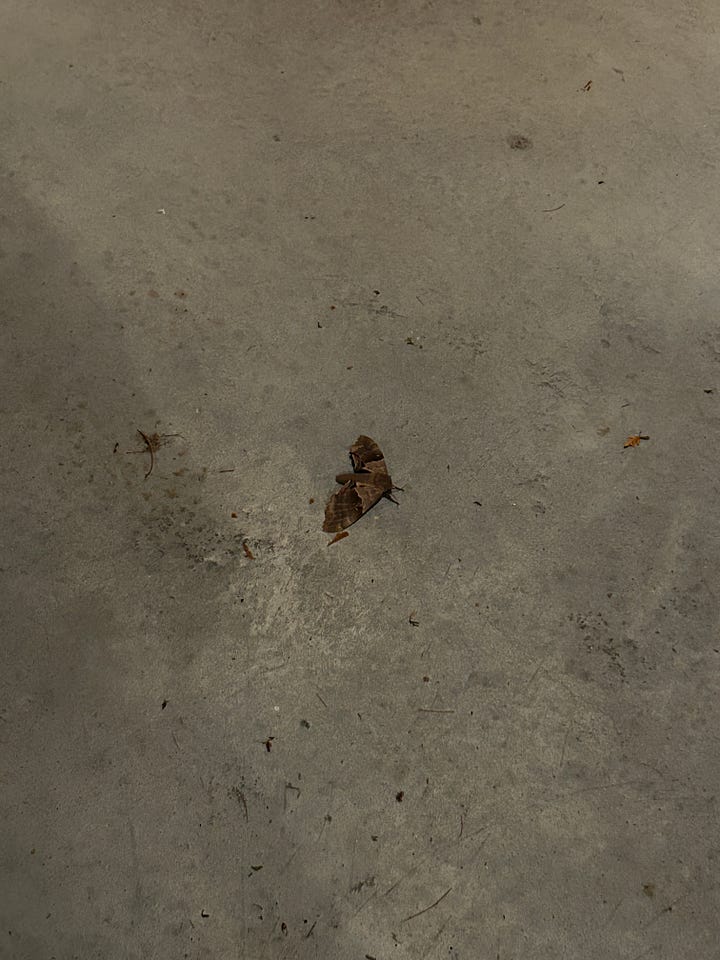
I’m so excited to tell you about big moths. It’s interesting that there’s this harsh dichotomy between how people perceive butterflies vs. how they perceive moths, but it’s definitely a thing. In pop culture they’re sort of death-analogs, and they tend to show up whenever something scary is going on in a movie. One of the villains of a favorite book of mine, Perdido Street Station, is a giant brain-eating moth. I think people are more freaked out by moths because butterflies display themselves proudly in daylight while most moths sneak around in the night. And they’re always so silent, which is kind of spooky. And there’s tons of stories of people opening a drawer full of wool sweaters only for a swarm of moths to fly out, which is admittedly a gross thing that I hope never happens to me.
I think a lot of people also don’t know that moths can get really big, which would maybe make them even more scared of them, but I think that’s great! I love the idea of enormous, silent, harmless creatures floating around at night. Some of the biggest bugs in the world are moths — the Atlas moth, by wingspan, and the giant wood moth, by body mass. One of the moths you sent me during your trip is a member of the sphinx moth family1, which are some of my absolute favorites. They’re basically the dragons or fighter jets of moths with these wonderfully aerodynamic wingspans and hefty bodies, and they come in all sorts of different colors and patterns. Their caterpillars are hornworms, which are vegetable pests, but they grow into totally stunning adults, and I think more people would be okay with sacrificing a few tomatoes if they knew that.
We were all in the outdoor kitchen drinking tea when the sphinx moth flew in and I swear, I thought it was a bat. I mean, you could hear the weight of its wings flapping. I kept wondering why there were no bats where we were in the mountains and for two seconds I felt validated and then realized, okay, it’s just a huge bug the size of my hand. Speaking of moth in hand, can we talk about the beautiful perfect amazing sweet completely surreal rosy maple moth which I DID carry in my hand to get it into a safe place?
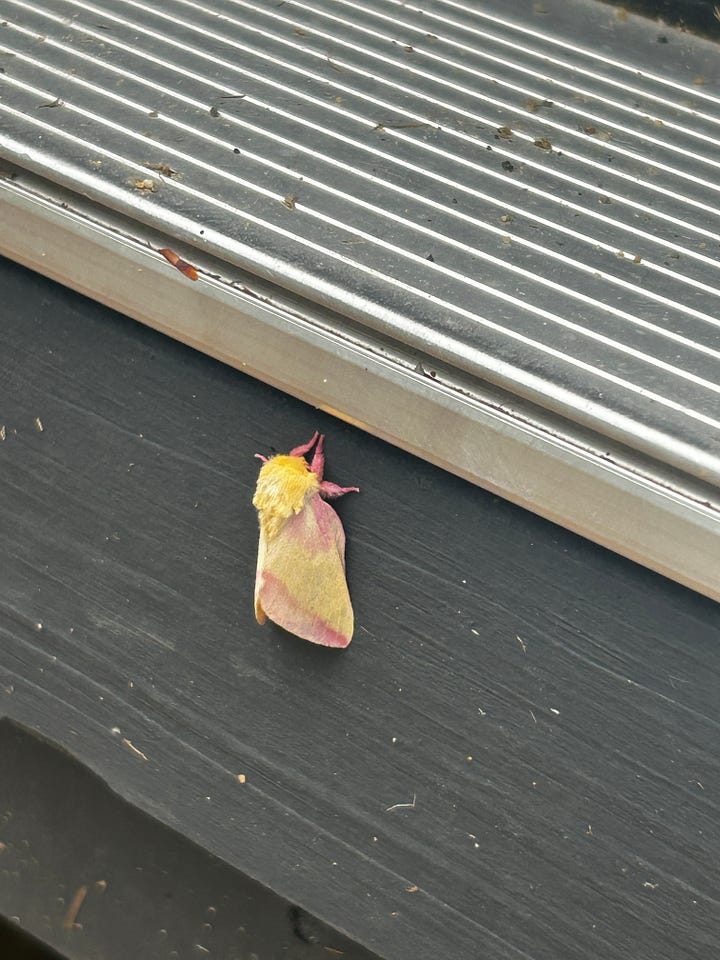


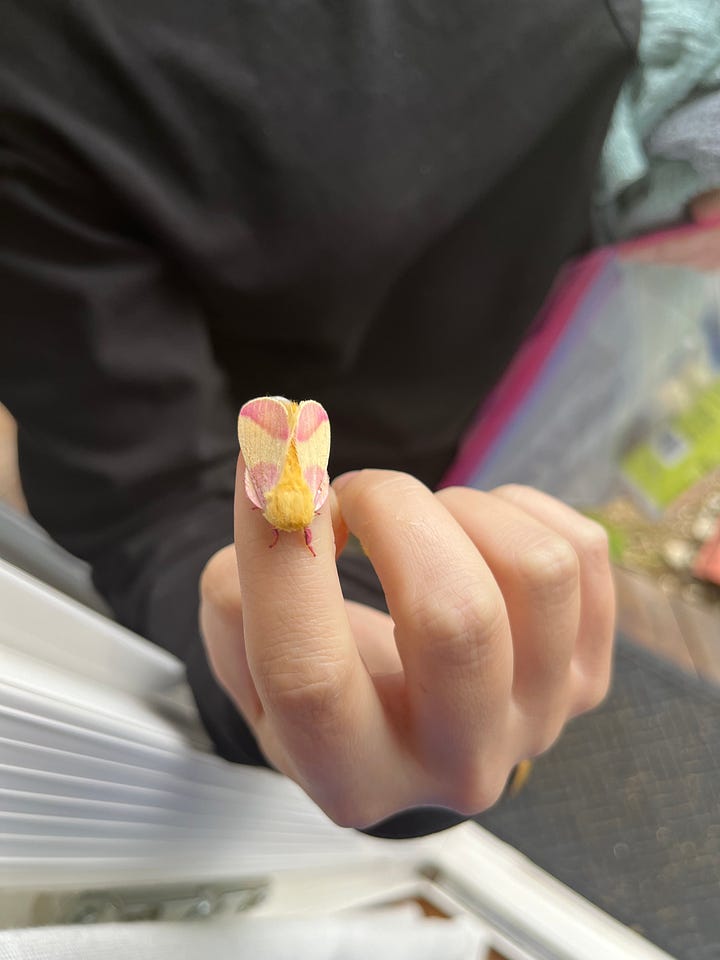
I am truly so envious of you that you got to interact with one of these. Rosy maple moths are sort of “big online” right now in that they are very outwardly, obviously cute, and when bugs (usually gross) are cute, people tend to love that. They look like stuffed animals, or pieces of gummy candy, and their color is so vibrant they almost don’t look real. Even their name “rosy maple” sounds sweet and nice. They are the smallest of the silkmoths, and their caterpillars eat the leaves of a few types of maple trees. The seeds of the red maple tree grow in pairs with little helicopter wings whose coloring nearly matches the pink-and-yellow pattern of their moths.
Objectively, the best bug I’ve seen in my whole life. The bug that puzzled me the most, however, was a bug you identified as a yellow spotted millipede. I’ve seen millipedes in the wild before, but in Cambodia where they were giant. This one was much smaller — thankfully — but then you told me something harrowing, which is that it sprays, uh, cyanide?
Yes! There are a few bugs out there that actually have the capability to spray toxins at predators, like the bombardier beetle, which can spray a boiling hot chemical compound from their butts that can kill other insects, and the two-striped walking stick, which can spray a similarly defensive chemical from glands behind their head. Upon further googling, the millipede you sent me is a yellow and black flat millipede, the Eastern cousin of the West Coast yellow spotted millipede, both of which do indeed “exude” cyanide from their bodies as a defense. It’s more irritating than dangerous to us, though it could kill something smaller. They tend to smell like almonds, because cyanide smells like almonds. Did you get close enough to take a whiff?
No… I kept my distance, mostly because I try not to touch something with too many legs. I feel like it’s late enough in the post for us to do Fran Mag x Bugstack after hours, AKA talk about the bugs that are scary. This guy haunted one of our bathrooms for a few days, but what was more scary than his size was his total incapability of flying. Who is this and why does he suck so much at being a bug?
I believe that this is a crane fly, and being bad at flying is sort of typical for them. There are lots of myths about them biting people or hunting mosquitoes, both of which are not true. A lot of them don’t even have mouths — like a lot of bugs who go through some form of metamorphosis, their adult bodies are meant for mating and mating only, and most crane flies live as adults for just a few days before dying. They’re out here to find love just like the rest of us. They tend to congregate in weird places like bathrooms or cellars, and they have all these behaviors like swarming in random places and hanging out in spiderwebs that no one really knows the reason for. According to a bunch of posts I just saw on the internet, the fear of crane flies specifically is called “tipulophobia,” but I have no way of knowing if this is a genuine thing or an internet misinformation thing. Hard to tell these days! What other bugs did you see that could spawn their own phobias?
I saw two different kinds of spiders — photos of which I’ll opt to not post, for fear of alienating the more arachnophobic set of Fran Magazine readers. I saw a ton of the expected daddy longlegs and something you identified at the time as maybe a parson spider? Aren’t both of these venomous in their own ways?
Parson spiders are! Spiders tend to have venom, and it’s the potency that is the main concern with anything bigger than prey (us). I used to see parson spiders all the time at my parents’ house just cruising around, usually in my bedroom, and apparently their bites can cause an allergic reaction in some people. They’re called parson spiders because the white marking on their back looks like a cravat worn by 1700s clergymen.
I am happy to say that the daddy longlegs venom thing is a myth. It mainly has to do with what you’re referring to when you call something a daddy longlegs, since it’s a colloquial term that gets used for three very different things. The first is a crane fly, which is not a spider, and doesn’t have a mouth. Another is what is also known as a harvestman, which is the daddy longlegs I grew up with, and which is, as it happens, also not a spider. They have eight legs but only two eyes (spiders have eight) and one body part (spiders have two). And the third is something called a cellar spider, which is a spider and is venomous, but not dangerous to us. This very comprehensive article from the Forest Service explains that the myth may have come about because cellar spiders can sometimes catch and eat black widows, and if they can overpower something that dangerous, they must be pretty deadly, but it’s just not true. When they catch widows it’s because of their webs, not their — admittedly pretty mild — venom.
Okay, learning now from some photos that what I was seeing a bajillion of out there were the harvestmen, which I love the sound of. I like any bug name that makes it sound like the bug has a job. My last question for you (maybe is too open-ended but let’s try it out): knowing what you know about native bugs in the northeast, what bug do you wish that I had seen up in the mountains?
I would have loved for you to have seen an Io moth. I think they are maybe rarer in that area than in other more midwestern parts of the U.S., but they’re really stunning. The males are a beautiful bright yellow with red markings near their bodies that look like strokes of paint, and two big black-and-blue eye spots on their lower wings. They’re furry and sort of sweet-looking like the rosy maples but bigger, maybe half the size of your palm. I’ve always wanted to see one, and if you’re in the right area you can set up light traps to catch them. A Hercules beetle sighting would have also been cool. There’s nothing better than going somewhere far from city lights and finally getting to see the really big bugs. Some may disagree with me on that.
Pictured above on the left






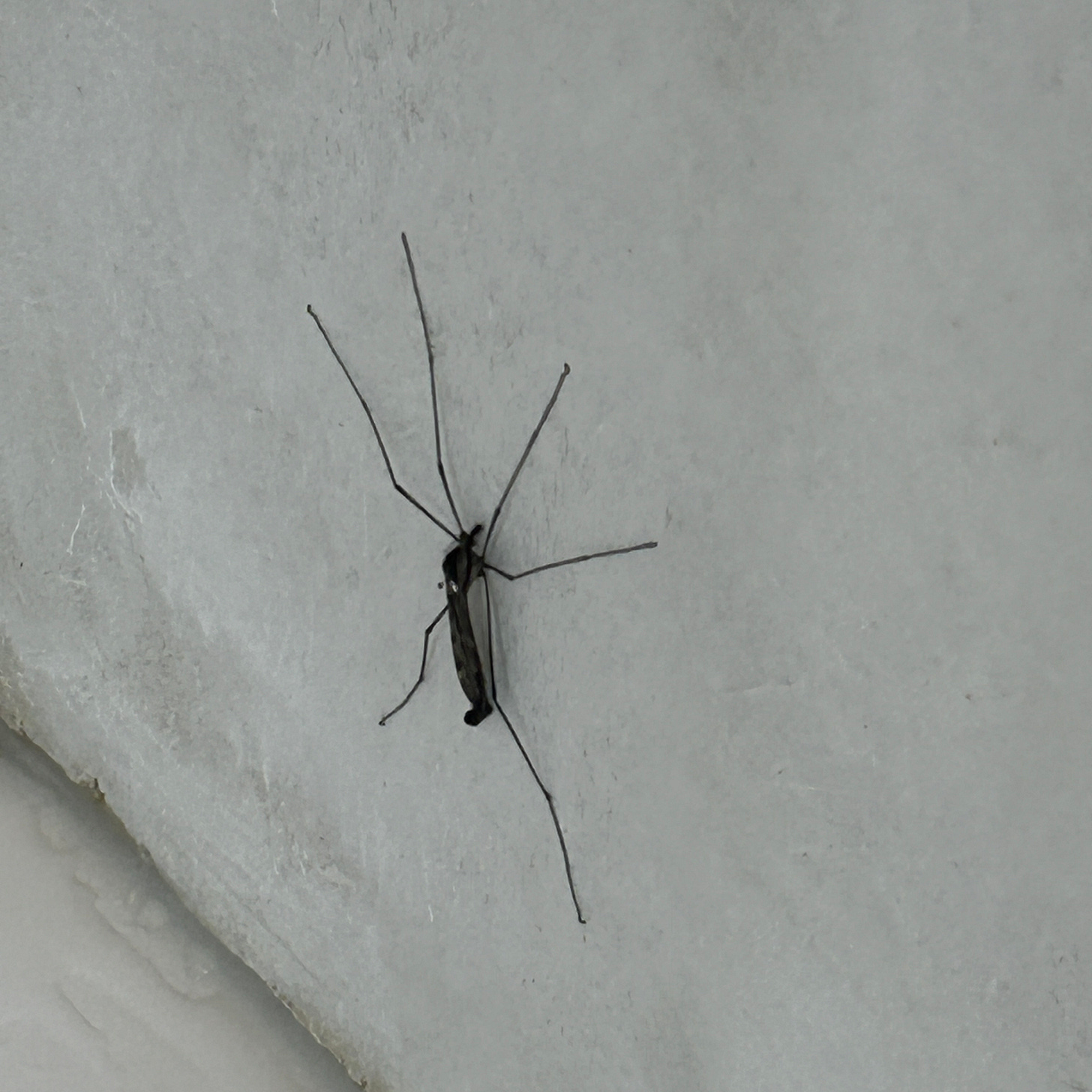

Since I'm almost as old as television, I have seen a LOT of crossover episodes. This, hands down, is the BEST "crossover" I have ever seen, in any medium, in MY ENTIRE LIFE. Thank you.
Bug Magazine? Franstack?